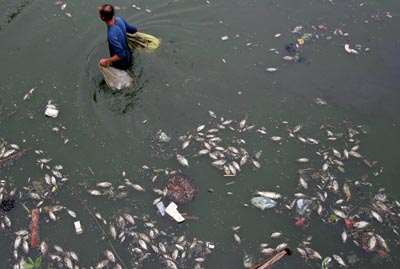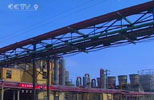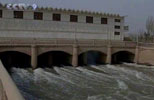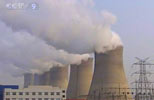BEIJING, Sept. 12 Via Xinhuanet-- "China Green National
Accounting Study Report 2004" was issued jointly to the public by the
State Environmental Protection Administration of China (SEPA) and the
National Bureau of Statistics of China (NBS) on Sept. 08, 2006.
The report, the first of its kind on
environmentally-adjusted GDP accounting in China, and marks the fact
that the initial progress had been achieved on Chinese green GDP
accounting.
The preliminary results show that
economic loss caused by environmental pollution reaches 511.8 billion
yuan, accounting for 3.05% of national GDP in 2004 while imputed
treatment cost is 287.4 billion yuan, accounting for 1.80% of that.
Vice Minister Pan Yue of SEPA and
Commissioner Qiu Xiaohua of NBS both indicated that the calculated
environmental damage cost is only part of actual resources and
environmental costs due to localization of departments and limits to
technologies, and the integrated green GDP accounting still needs more
arduous efforts and has a long way to go.
Green National Accounting (Green
GDP Accounting for short) refers to an accounting system deducting
natural resources depletion costs and environmental degradation costs
,so as to assess the quality of economic development in real sense.
The Green GDP Accounting Research
Project was launched in March 2004 jointly by SEPA and NBS. In the past
two years, the technical team conducted accounting analysis on physical
quantification of environmental pollution, imputed treatment cost and
environmental degradation cost for 42 industries and 3 regions of the
East, the Central and the West China.
According to the accounting
conclusion, economic loss caused by environmental pollution is 511.8
billion yuan, accounting for 3.05% of national GDP in 2004. Of the
figure, environmental costs by water pollution, by air pollution and by
solid wastes and pollution accidents are 286.28 billion yuan, 219.8
billion yuan and 5.74 billion yuan, accounting for 55.9%, 42.9% and
1.2% of the total costs, respectively.
According to Pan Yue and Qiu
Xiaohua, an integrated environmental and economic accounting system
should cover at least five types of natural resources depletion costs
(land, minerals, forest, water and fishery resources) and two types of
environmental degradation costs (environmental pollution cost and
ecological damage cost).
Because of limitation to basic data
and technical approaches, the accounting results in 2004 only represent
the environmental pollution cost, without accounts of costs of natural
resources depletion and ecological damage.
The environmental pollution costs
should include costs of over 20 items while the current Chinese Green
GDP accounting only covers costs of 10 items (health, agricultural and
materials losses caused by air pollution; health, industrial and
agricultural production losses, and water shortage caused by water
pollution; economic loss caused by land occupation of solid wastes and
etc.).
Groundwater, soil contamination and
other key items are not dealt with in the accounting. On the whole,
this accounting result is only a fraction of ultimate green GDP
calculation result.
In addition, some underestimates
and missing items existed in the calculated costs of 10 items. Even so,
the environmental pollution cost has accounted for 3.05% of the GDP.
This striking figure just demonstrates that environmental pollution is
quite serious at present.
Apart from environmental pollution
cost, pollution discharge amounts and treatment costs are also taken
into calculation in the Green GDP accounting.
The calculation result shows that
the one-off direct investment of about 1,080 billion yuan, accounting
for about 7% of the GDP that year, should be required if all the
discharged pollutants from point source were treated or disposed of in
2004.
Moreover, the additional operation
expenses of 287.4 billion yuan (imputed treatment cost) are also needed
for treatment, which accounts for 1.8% of the GDP in 2004. In fact, the
pollution abatement and control investment only accounted for 1.18% of
the GDP during the "Tenth Five-year Plan" period, which is of great gap
with the accounting result.
Pan Yue and Qiu Xiaohua also
indicated that the accounting result is sufficient to roughly estimate
the current economic and environmental situation even if it is still
not complete.
The calculated figures again prove
that environmental crisis is more and more severely restricting
economic development of China. In the traditional industrialization
pattern, the GDP figure on the increase is based on the overdraft of
resources and environment and public health.
Even though the economic growth
characterized by "high consumption, high pollution and high risk" is of
its own historical significance in China, China's economy has been in
the bottleneck period of resources and energy today and it cannot bear
any risks of resources exhaustion.
Meanwhile, Chinese society has also
entered the period with various conflicts protruding in which per
capita GDP is about 1,000-3,000 US dollars, which cannot bear up any
social problems caused by environmental pollution.
The Central Committee of the
Chinese Communist Party put forward the setting of concept of
scientific development and building a harmonious society of China, and
then building of a resources-conserving and environment-friendly
society.
This means a significant
sublimation of the political concept in China and provides a good
opportunity for the Chinese economic growth pattern changing from
traditional industrialization into new industrialization.
However, any good concept or
ideology must be supported or ensured by a stable and firm system. If
we cannot develop a set of comprehensive or objective measurement
indicator system for economic growth, it will be impossible for us to
achieve the set goals of setting a scientific development concept and
building of a harmonious society of China.
Pan Yue noted that it would be a
very long process to establish a green national economic accounting
system ultimately as a result of obstacles in technology and system.
But it will be too late if we don't
take action until all the pre-conditions become mature. We have to
tackle thorny problems one by one. If one project was conducted, we
would tackle one problem; if one problem was settled, we would release
it to the public.
The further tasks of the working
group should be as following: first, to improve accounting methods and
conduct green national accounting as routine work.
SEPA will conduct three basic
surveys in succession such as a nationwide pollution sources Surveys, a
nationwide groundwater pollution investigation and a nationwide soil
contamination investigation together with other departments concerned
to supplement this accounting basis.
Moreover, the national survey for
ecological damage loss will be launched soon in order to lay the
foundation for calculation of overall environmental degradation cost;
second, SEPA will place emphasis on research on how to formulate
environmental and economic management policies related to pollution
control, environmental revenue, ecological compensation and performance
examination of governmental officers by using calculation results of
green national accounting.
Since the report has analyzed the
data regarding 42 industries and 3 regions and compared the
environmental pollution situation in different industries or regions,
SEPA will be facilitated to identify emphases of pollution control,
collocate industrial environmental protection functional zones and
coordinate regional development orientation with a definite objective,
in order to promote sustainable development of regional economies.
Qiu Xiaohua said it was the common
topic for statistical departments of the world all the time and it is
an important task for the Chinese statistical department to explore
green national economic accounting.
The National Bureau of Statistics
will implement the requirements of the State Council to provide
guarantee or support for the implementation of the scientific
development concept, vigorously push forward research and practicical
work of green national economic accounting together with departments
concerned.
The experts' assessment meeting for
Green GDP Accounting Research was held jointly by SEPA and NBS in
Beijing in July 2006. The experts group consisting of academicians and
experts from the Chinese Academy of Sciences (CAS), Chinese Academy of
Engineering (CAE), Chinese Academy of Society and Science (CASS) highly
appraised the Green GDP accounting research.
The experts group is of the view
that accounting technology and methodology put forward in the project
research are scientific and rational, which have laid a solid
foundation for the establishment of an integrated environmental and
economic accounting system and been of great reference significance for
integrated decision-making on environment and economy.
The expert group also agrees that
the research is an important practice in following the people-oriented
principle and implementing the scientific development concept, which is
of innovative and landmark significance in Chinese environmental and
economic accounting, and has met advanced international standards.
Chinese Green National Economic
Accounting Research has drawn great attention at home and abroad and
obtained great support from international community.
The Ministry of Science and
Technology and the Ministry of Finance started the key national
scientific research project; The World Bank set up technology-aid
projects for specific purpose; the United Nations Environment Program
(UNEP), the UN Statistical Commission, the Economic and Social
Commission for Asia and the Pacific (ESCAP), the European Commission,
Norway, Netherlands and China Council for International Cooperation on
Environment and Development (CCICED) also rendered positive appraisal
and encouragement for Chinese National Accounting Research.
In addition, the pilot or
experimental work has been done in Beijing Municipality, Tianjin
Municipality, Chongqing Municipality, Hebei Province, Liaoning
Province, Anhui Province, Zhejiang Province, Sichuan Province,
Guangdong Province and Hainan Province in support of Chinese Green
National Accounting Research.
Nearly 30% of key industrial
pollution enterprises, all the sewage plants, garbage treatment plants,
big livestock and poultry breeding farms and 30,000 households were
surveyed in the 10 provinces and cities.
Besides environmental protection
and statistical governments, the health, agricultural, water
conservancy, civil construction, transportation and other related
governments were also involved in the survey. At present, the pilot
work has been going smoothly in China and is expected for completion
before the end of 2006.
Pan Yue and Qiu Xiaohua stated in
conclusion that no any other country had ever conducted the complete
and comprehensive environmental and economic accounting.
Therefore, Chinese environmental
and economic accounting research makes a good attempt for the
developing countries in the field of Green GDP accounting. SEPA and NBS
are planning to further expand accounting scopes, improve accounting
approaches and gradually establish a Chinese regular system of
environmental and economic accounting report.
(Provided by Chinese Academy for Environmental Planning)
Technorati Tags:
china,
green gdp





 A report delivered in August at the NPC standing committee showed
that the level of envrionmental pollution in China is still on the up
but at a slower rate than before. The environmental authority has
called for amendment of the environmental law.The current law was
enacted in 1989 and has not been revised since. China has set a goal of
cutting pollution output by 10 percnet, adjusted for economic growth,
over the next five years. A nationwide network for environmentla
inspection will also be set up by then.
A report delivered in August at the NPC standing committee showed
that the level of envrionmental pollution in China is still on the up
but at a slower rate than before. The environmental authority has
called for amendment of the environmental law.The current law was
enacted in 1989 and has not been revised since. China has set a goal of
cutting pollution output by 10 percnet, adjusted for economic growth,
over the next five years. A nationwide network for environmentla
inspection will also be set up by then.








